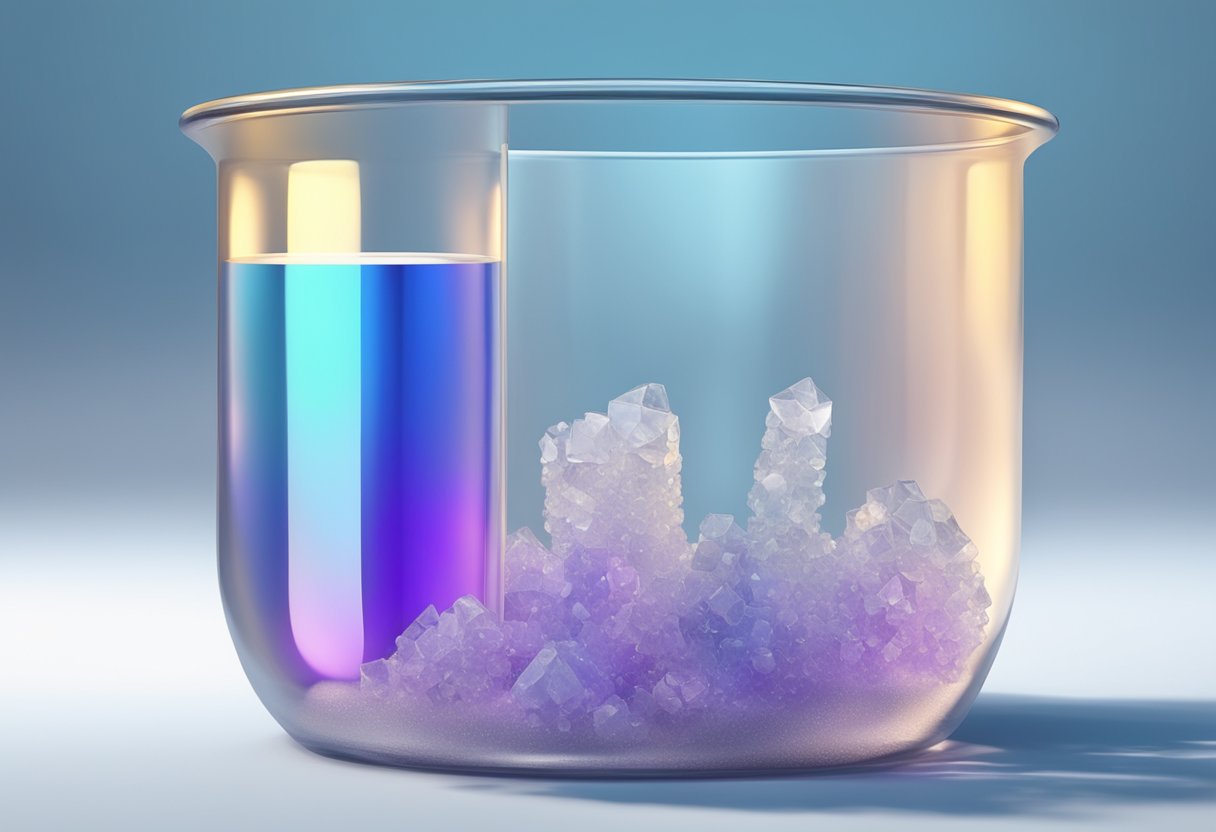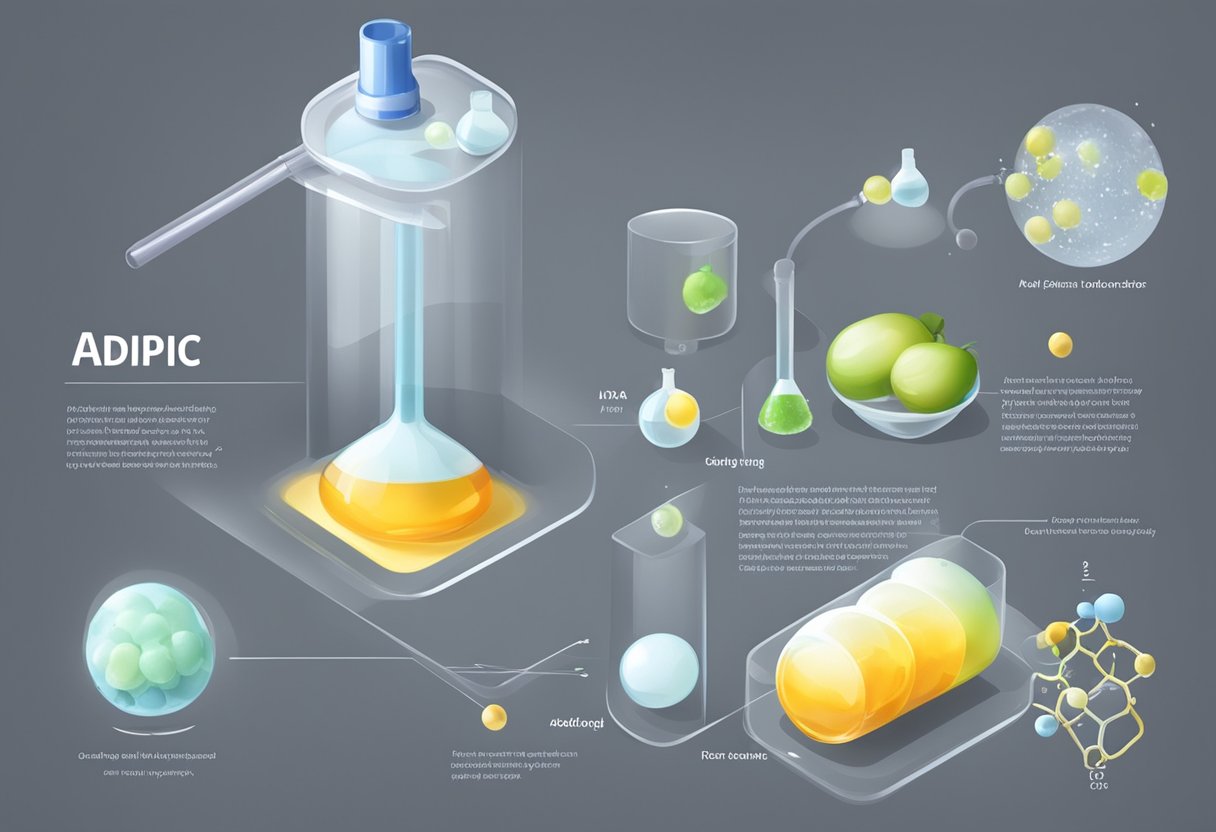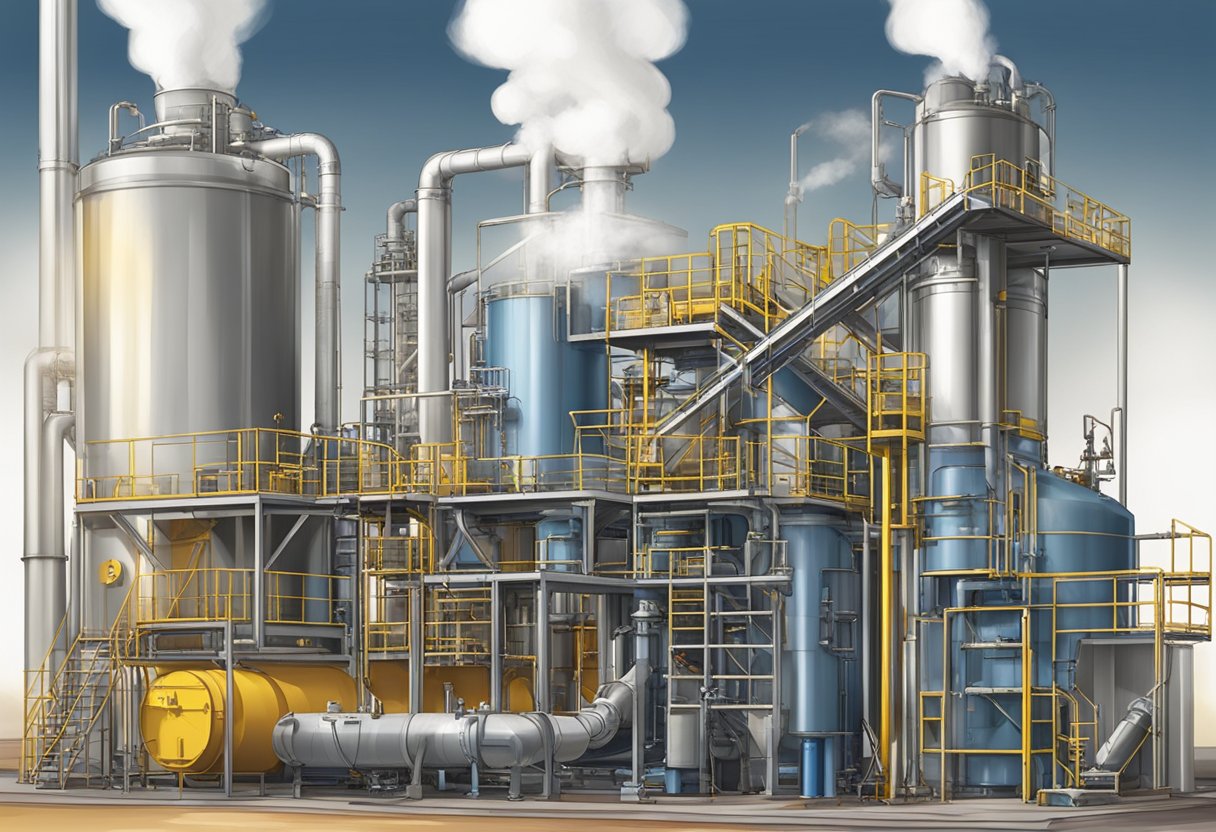Adipic Acid is a Versatile Chemical Used in Various Industries
19/01/2024
Adipic acid is a white crystalline powder that is commonly used in the production of nylon fibers and plastics. It is a dicarboxylic acid that contains two carboxyl groups (-COOH) and is considered a moderately strong organic acid. Adipic acid is also used as a food additive to adjust the acidity of certain foods and beverages.

One of the main uses of adipic acid is in the production of nylon fibers and plastics. It is a key ingredient in the synthesis of nylon-6,6, which is used in a variety of applications such as clothing, carpeting, and automotive parts. Adipic acid is also used in the production of other types of nylon, including nylon-6 and nylon-6,10.
Aside chem from its use in the production of nylon, adipic acid is also used as a food additive. It is commonly used to adjust the pH of certain foods and beverages, such as fruit juices, soft drinks, and gelatin desserts. Adipic acid is generally recognized as safe by the U.S. Food and Drug Administration (FDA) and is considered a non-toxic and non-carcinogenic substance.
Chemical Properties

Molecular Structure
Adipic acid is a dicarboxylic acid with the molecular formula C6H10O4. It is a white crystalline powder with a molecular weight of 146.14 g/mol. The molecule consists of two carboxylic acid groups (-COOH) attached to a six-carbon chain (-C6H10-) with two oxygen atoms (-O-) in the middle. The carbon atoms in the chain are arranged in a zig-zag pattern, and the two carboxylic acid groups are located at opposite ends of the molecule.
Physical Characteristics
Adipic acid has a melting point of 152-153°C and a boiling point of 337°C. It is soluble in water, ethanol, and ether, and insoluble in benzene and chloroform. Adipic acid is a stable compound and does not decompose at normal temperatures. It has a slightly acidic taste and odor.
Adipic acid is commonly used in the production of nylon, polyurethane, and other polymers. It is also used as a food additive and is approved by the FDA for use as a flavoring agent and acidulant in food. Adipic acid is generally recognized as safe (GRAS) when used in accordance with good manufacturing practices.
Production

Industrial Synthesis
Adipic acid is a dicarboxylic acid widely used in the production of nylon 6,6, polyurethanes, and other industrial applications. The industrial synthesis of adipic acid is typically carried out by the oxidation of cyclohexane or cyclohexene with nitric acid or oxygen. The process involves several steps, including oxidation, nitration, and hydrolysis.
The oxidation of cyclohexane or cyclohexene with nitric acid or oxygen is the first step in the industrial synthesis of adipic acid. The reaction produces a mixture of cyclohexanone and cyclohexanol, which are then oxidized to form adipics acid. The oxidation of cyclohexanone and cyclohexanol is typically carried out using a mixture of nitric acid and air or oxygen.
The nitration of cyclohexane or cyclohexene is another method used in the industrial synthesis of adipic acid. The reaction produces a mixture of nitrocyclohexane isomers, which are then hydrolyzed to form adipic acid. The hydrolysis step involves the use of sulfuric acid and water to convert the nitrocyclohexane isomers to adipic acid.
Raw Materials
The raw materials used in the industrial synthesis of adipics acid include cyclohexane or cyclohexene, nitric acid, and sulfuric acid. Cyclohexane and cyclohexene are obtained from petroleum refining and are readily available. Nitric acid is typically produced by the oxidation of ammonia, while sulfuric acid is produced by the contact process.
The production of adipics acid is energy-intensive and generates significant amounts of waste. The use of renewable raw materials and alternative production methods, such as biotechnology, are being explored as a means of reducing the environmental impact of adipics acid production.
Applications
Plastics Production
Adipic acid is a key ingredient in the production of nylon 6,6, which is used in the manufacture of various products such as automotive parts, electrical equipment, and textiles. It is also used in the production of other types of plastics, including polyurethanes, polyester resins, and thermoplastic polyesters.
Food Additive
Adipic acid is used as a food additive to enhance the flavor of certain foods, such as baked goods and gelatin desserts. It is also used as a buffering agent in some beverages to help maintain their pH levels.
Other Uses
Aside from its use in plastics and as a food additive, adipics acid has other applications. It is used in the production of synthetic lubricants, as a corrosion inhibitor in metalworking fluids, and as a component in some pharmaceuticals. It is also used in the production of polyurethane foams, which are used in the manufacture of furniture and insulation materials.
Overall, adipic acid is a versatile chemical with a wide range of applications in various industries. Its properties make it an important ingredient in the production of many different products, and its use as a food additive ensures that it is a familiar substance to many people.
Environmental Impact
Biodegradability
Adipic acid is considered to be biodegradable. When released into the environment, it can be broken down by microorganisms. The rate at which adipics acid biodegrades depends on various factors such as temperature, pH, and the presence of other substances. However, under normal conditions, adipic acid is expected to biodegrade within a few weeks to months.
Emissions
The production of adipics acid can result in emissions of greenhouse gases such as carbon dioxide and nitrous oxide. These emissions are primarily associated with the production of the raw materials used to manufacture adipic acid. The amount of greenhouse gas emissions varies depending on the production process used and the energy sources used to power the process.
Furthermore, the production of adipics acid can also result in the release of other pollutants such as sulfur dioxide and nitrogen oxides. These pollutants can contribute to air pollution and have negative impacts on human health and the environment.
Overall, while adipics acid is biodegradable, its production can have negative environmental impacts. It is important to continue to develop and implement sustainable production processes to minimize these impacts.
Health and Safety
Toxicology
Adipic acid is generally considered safe for use in various applications. The compound has a low toxicity level and is not known to cause any significant health effects when used properly. However, it can cause mild irritation to the eyes, skin, and respiratory tract if it comes in contact with them.
Inhalation of adipics acid dust or vapors can cause irritation to the respiratory tract, leading to coughing, wheezing, and shortness of breath. Prolonged or repeated exposure to high levels of adipic acid can cause lung damage.
Ingestion of adipics acid is generally considered safe in small amounts, but large doses can cause gastrointestinal irritation, nausea, vomiting, and diarrhea.
Handling and Storage
Adipic acid should be handled with care to prevent skin and eye contact. Appropriate personal protective equipment, such as gloves and safety goggles, should be worn when handling the compound. In case of skin or eye contact, the affected area should be washed thoroughly with water.
Adipic acid should be stored in a cool, dry, and well-ventilated area away from sources of heat and ignition. The compound should be kept in a tightly sealed container to prevent moisture absorption.
In summary, adipics acid is generally considered safe for use in various applications as long as proper handling and storage procedures are followed. However, it can cause irritation to the eyes, skin, and respiratory tract if not handled properly.
Market Data
Demand
Adipics acid is a key ingredient in the production of nylon 6,6, a widely used polymer in the textile and automotive industries. The demand for adipic acid is therefore closely tied to the demand for nylon 6,6. The global demand for adipics acid was estimated to be around 2.8 million tons in 2020, with a projected compound annual growth rate (CAGR) of 3.5% from 2021 to 2028.
The Asia-Pacific region is the largest consumer of adipics acid, accounting for more than 50% of the global demand. This is primarily due to the rapid growth of the textile industry in countries such as China, India, and Bangladesh. The demand for adipics acid in North America and Europe is expected to grow at a slower pace due to the maturity of the textile and automotive industries in these regions.
Supply Chain
The production of adipic acid involves several steps, including oxidation of cyclohexane or benzene, nitration, and hydrogenation. The major players in the adipics acid market include BASF SE, Invista, Lanxess AG, Ascend Performance Materials, and Radici Group. These companies have established a strong global presence through strategic partnerships and acquisitions.
The production of adipics acid is energy-intensive and requires large amounts of water and raw materials. The environmental impact of adipics acid production is a growing concern, and companies are investing in sustainable production methods such as bio-based production and carbon capture technologies.
Overall, the adipics acid market is expected to grow steadily in the coming years, driven by the increasing demand for nylon 6,6 in various industries. However, the market is also facing challenges such as environmental concerns and volatile raw material prices, which may impact the growth of the market in the long run.
Regulatory Aspects
Global Regulations
Adipic acid is regulated globally by various organizations such as the European Chemicals Agency (ECHA), the United States Environmental Protection Agency (EPA), and the Ministry of Health, Labour and Welfare in Japan. In the European Union, adipics acid is classified as a hazardous substance and is subject to strict regulations under the Registration, Evaluation, Authorization, and Restriction of Chemicals (REACH) regulation. The use of adipic acid is also regulated by the EPA in the United States, which has set limits on its use in various applications.
Compliance
Manufacturers and users of adipic acid must comply with regulations set by the relevant regulatory bodies in their respective countries. Compliance involves adhering to safety guidelines for handling and storage of adipics acid, as well as ensuring that its use is in accordance with the regulations set by the relevant authorities. Manufacturers are also required to provide information on the safety and environmental impact of adipic acid to their customers and regulatory bodies.
Overall, regulatory compliance is essential to ensure the safe and responsible use of adipic acids in various applications. Manufacturers and users must remain up-to-date with the latest regulations and guidelines to ensure that they are in compliance with all relevant requirements.
Technological Advancements
Production Innovations
Adipic acid is traditionally produced through the oxidation of cyclohexane, a petroleum-derived compound. However, recent technological advancements have led to the development of new production methods that are more efficient and cost-effective. One such method involves the use of biocatalysts, which can convert renewable resources such as glucose and xylose into adipic acid. This method has the potential to significantly reduce the environmental impact of adipic acids production.
Another promising production innovation is the use of ionic liquids as solvents in the oxidation process. Ionic liquids are salts that are liquid at room temperature and have been shown to increase the selectivity and efficiency of the oxidation reaction. This method also has the potential to reduce the amount of waste generated during production.
Sustainable Alternatives
As concerns about the environmental impact of petroleum-derived products continue to grow, researchers are exploring sustainable alternatives to traditional adipic acid production methods. One such alternative is the use of bio-based feedstocks, such as plant-based sugars and lignocellulosic biomass, to produce adipic acid. This method has the potential to reduce greenhouse gas emissions and decrease reliance on non-renewable resources.
Another sustainable alternative is the use of carbon dioxide as a starting material in adipic acid production. This method involves the conversion of carbon dioxide into adipic acids using renewable energy sources such as solar or wind power. This approach has the potential to significantly reduce the carbon footprint of adipic acid production.
Overall, these technological advancements and sustainable alternatives offer promising solutions for the production of adipic acid that are both environmentally friendly and cost-effective.
Future Prospects
Market Trends
Adipic acid is expected to have a bright future in the market, due to its increasing demand in various applications. The global adipic acid market size is projected to grow steadily in the coming years, driven by the increasing demand for nylon 6,6 and polyurethane (PU) resins.
The growing automotive industry is also expected to drive the demand for adipic acids, as it is used in the production of automotive parts such as bumpers, dashboards, and steering wheels. Additionally, the increasing demand for adipic acid in the food and beverage industry as a flavoring agent is expected to further boost the market growth.
Research Directions
Research and development activities are focused on finding new and innovative applications of adipic acids. The development of bio-based adipic acid is gaining traction as it offers a sustainable and eco-friendly alternative to traditional adipic acid.
Moreover, research is being conducted to find new methods of producing adipic acids that are more cost-effective and efficient. The use of renewable energy sources in the production process is also being explored to reduce the carbon footprint of the manufacturing process.
In conclusion, the future prospects of adipic acids look promising, with increasing demand in various applications and ongoing research and development activities to find new and innovative applications and production methods.
References
Adipic acid is a dicarboxylic acid that is commonly used in the production of nylon and other polyamides. It is also used as a food additive and in the production of various other chemicals.
Some of the key references for adipic acid include:
- “Adipic Acid.” Chemical Safety Facts. Accessed January 19, 2024. https://www.chemicalsafetyfacts.org/adipic-acid/.
This website provides an overview of adipics acid, including its properties, uses, and safety information. It also includes information on the production and transportation of adipic acid.
- “Adipics Acid.” PubChem. Accessed January 19, 2024. https://pubchem.ncbi.nlm.nih.gov/compound/adipic_acid.
This database provides detailed information on the chemical properties of adipics acid, as well as its uses, safety information, and environmental impacts. It also includes references to relevant scientific studies and articles.
- “Adipic Acid.” European Chemicals Agency. Accessed January 19, 2024. https://echa.europa.eu/substance-information/-/substanceinfo/100.000.143.
This website provides regulatory information on adipics acid, including its classification, labeling, and safety data sheets. It also includes information on the uses and production of adipics acid in the European Union.
Overall, these references provide a comprehensive overview of adipics acid, including its properties, uses, and safety information. They can be useful resources for anyone working with or studying this important chemical.




